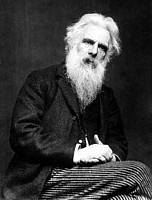BIOGRAPHY

1830-1904
Eadweard J. Muybridge was an English photographer who spent much of his life in the United States. He is known for his pioneering work on animal locomotion which used multiple cameras to capture motion, and his zoopraxiscope, a device for projecting motion pictures that pre-dated the flexible perforated film strip.
Muybridge emigrated to the US, arriving in San Francisco in 1855, where he started a career as a publisher's agent and bookseller. He left San Francisco at the end of the 1850s, and, after a stagecoach accident in which he received severe head injuries, returned to England for a few years. While recuperating back in England, he seriously took up photography sometime between 1861 and 1866, where he learned the wet-collodion process.
In 1872 Muybridge used a series of cameras to take sequential pictures of a running horse. As the horse passed each camera, it tripped a wire that set off the camera shutter. Muybridge improved the shutter mechanism of his camera so that it could take a 1/2000 of a second exposure.
In 1880 Muybridge produced the Zoopraxiscope to project photographs in rapid succession, thus creating a primitive form of motion pictures. After a three-year lecture tour in Europe, Muybridge received support for his research from the University of Pennsylvania. By 1885 he had taken more than 100,000 photographs of moving animals and humans. These images were made available in his Animals in Motion (1899) and The Human Figure (1901), which allowed scientists and artists to refine their understanding of animal movement.
